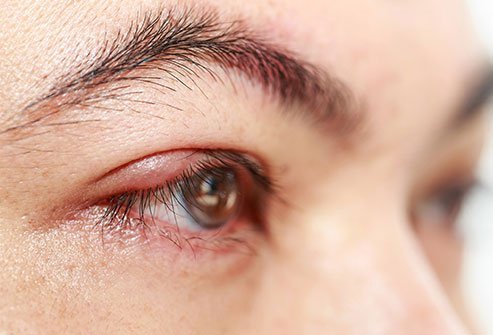What Causes a Stye in Your Eye?
What is a stye?

A stye (sometimes spelled as “sty”) is an infection of the oil glands that are along the edge of the eyelash. It is a red, painful bump that might appear like a pimple. A stye can form either on or inside the eyelid near the edge of the eyelashes. An external stye, the one appearing on the outside of the upper or lower eyelid, is more common than an internal stye that appears on the inside of the upper or lower eyelid.
The medical term for a stye is a hordeolum. A chalazion is also a bump-like swelling in the eyelid. But unlike a stye, a chalazion is not painful. It appears farther back on the eyelid and is not caused by infection; rather, it is caused by clogging of the opening of the oil-producing glands. Both the chalazion and stye can require similar treatment. However, a chalazion may take longer to heal than a stye.
Why do I get styes in my eye?
Several oil-producing glands are present on your eyelid to lubricate your eyes. Stye is caused when bacteria infect these glands and can occur without an identifiable initiating event. Several factors can put you at risk of getting a stye:
- Lack of hygiene
- Sharing cosmetics
- Using cosmetics after their expiration dates
- Sleeping without removing eye makeup
- Touching your eyes without washing your hands
- Use of infected contact lenses: not properly disinfecting contact lenses, not washing hands before using contact lenses
- Hormonal changes
- Lack of minerals and vitamins in the diet
- Lack of sleep
- Stress
- Sharing clothes, face towels and spectacles/glasses with people who have styes
- Diabetes
How do I get rid of a stye overnight?
You cannot get rid of a stye overnight. Styes often disappear on their own in a few days. Although it might be tempting, never try to pop a stye like a pimple. The golden rule is keep your hands away from the stye.
To reduce pain and swelling:
- Soak a clean washcloth in warm water, wring out excess water, and apply to the eyelid. Do this for 10 to 15 minutes at a time. Repeat three to five times a day.
- Gently wipe the eyelid with mild soap such as no-tears baby shampoo and water or eyelid wipes (available in drug stores).
- If the pain is severe, take over-the-counter painkillers.
Also, follow these tips:
- Never touch, squeeze, or pop a stye.
- Do not rub or touch the eyelid.
- Until the eye heals, do not wear makeup or contact lenses.
When to see a doctor for treatment of a stye?
Medical treatment may be needed if the stye does not improve within 48 hours of self-care. Doctors may provide the following treatment:
- Incision and drainage of the stye under local anesthesia.
- Antibiotic ointment.
- Antibiotic eye drops.
- Antibiotic pills if the infection involves the area surrounding the stye. Antibiotic pills may also be needed after incision and drainage of an internal stye.
- Steroid injection into the stye.
What are the symptoms of a stye in the eye?
Stye symptoms include the following:
- An extremely painful red bump at the base of the eyelashes, along the edge of the eyelid
- Eyelid swelling
- The center of the bump may have a tiny pus spot
- Foreign body sensation (feeling like there is something in your eyes)
- Itching in the eyes
- Intolerance or sensitivity to light
- Increased tearing in the affected eye
- Crust formation in the affected eye
- Burning sensation
- Blurry vision
- Sticky discharge from the eye
- Pain on blinking
How can I prevent getting a stye in my eye?
- Wash your hands well, especially before touching your face and eyes.
- Wash your hands every time you wear or remove your contact lenses.
- Clean contact lenses before and after use with disinfectant and lens cleaning solution.
- If you use daily wear or other “limited use” lenses, discard them on the schedule recommended by your eye doctor.
- Remove contact lenses before sleep.
- Wash your face and remove makeup before going to bed.
- Do not use old or expired makeup.
- Do not share cosmetics with others.
- Eat a balanced diet.
- Do not share towels or clothes with someone who has a stye.
- Keep your blood sugar under control.
- Get a regular eye checkup.

